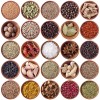Abstract
Herbs and spices have been used for hundreds of years in cooking and medicine. They add a wide range of flavors to food and may also provide health benefits. For some people, using herbs and spices in cooking may be a challenge, but it doesn’t have to be that way! The information below will get you on track to enjoying zesty, flavorful, healthy cooking. This 4-page fact sheet was written by Jenna A. Norris and Wendy Dahl and published by the UF Department of Food Science and Human Nutrition, April 2013.
References
Cantwell, M., and M. Reid. 2001. "Herbs (Fresh Culinary): Recommendations for Maintaining Postharvest Quality." UC Davis Postharvest Technology. http://postharvest.ucdavis.edu/pfvegetable/Herbs/.
CNN Interactive. 1998. "Herbs and Spices." http://www.cnn.com/HEALTH/indepth.food/herbs/chart.html.
Dermody, C. 2004. "The Shelf Life of Spices." Reader's Digest. http://www.rd.com/food/spice-shelf-life/.
Johns Hopkins Bayview Medical Center. 2001. "Herbs and Spices." http://www.hopkinsbayview.org/nutrition/patienteducation/healthydirections/herbs.html.
Spicer, F. 2003. "Herbs vs. Spices." Iowa State University Horticulture & Home Pest News. IC-489 (21). http://www.ipm.iastate.edu/ipm/hortnews/2003/8-22-2003/herbsnspices.html.
Stephens, J. 2010. "Seasoning with Herbs and Spices." K-State Research and Extension. http://www.ksre.ksu.edu/bookstore/Item.aspx?catId=390&pubId=12759.
Unless otherwise specified, articles published in the EDIS journal after January 1, 2024 are licensed under a Creative Commons Attribution-NonCommercial-NoDerivs 4.0 International (CC BY-NC-ND 4.0) license.

